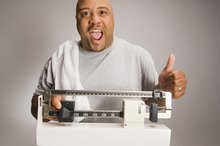How to Burn Subcutaneous Fat
Your body contains three forms of abdominal fat: retroperitoneal, visceral and subcutaneous. Visceral fat lies underneath muscle tissue around internal organs while retroperitoneal fat is found behind the abdomen along the back. Subcutaneous fat is located underneath the skin -- it’s the fat that you can physically grab. Burning subcutaneous fat requires a combination of proper eating, weight training and cardiovascular exercise.
Reduce your caloric consumption by at least 500 calories per day. One pound of body fat consists of 3,500 calories. Therefore, to lose a pound of fat you must burn 3,500 calories through a combination of diet and exercise. For example, if you typically consume 2,500 calories per day by reducing your daily caloric intake to 2,000 calories per day, you will cut your incoming calories by 3,500 per week. Focus on consuming complex carbohydrates such as vegetables, whole grains and fruits, as well as lean proteins.
How to Do Bicycles to Lose Belly Fat
Learn More
Perform 30 to 60 minutes of moderately-intense cardiovascular activity per day to help control weight and promote fat loss. The December 2006 issue of “Harvard Health Publications” outlines a study from Duke University Medical Center in which subjects who jogged 20 miles per week experienced subcutaneous and visceral fat loss. If you were jogging at 4.5 miles per hour, it would take you 13 minutes to complete one mile. Completing 20 miles per week at this pace consists of 260 minutes. When divided by seven days per week, the total breaks down to just more than 37 minutes per day. Therefore, it would be possible to receive the health benefits outlined by Duke University Medical Center by engaging in less than 40 minutes of jogging per day.
Engage in strength training exercises that target all major muscle groups at least two times per week. Weight training not only builds muscle mass, but aids in burning calories. A study published in the July 2007 edition of “Medicine and Science in Sports and Exercise” sought to determine the effects of weight training on subcutaneous fat loss. The participants, 45 men and 59 women, underwent 12 weeks of resistance training on one arm while avoiding training on the other arm. This study found both men and women showcased subcutaneous fat loss in the trained arm when compared to the untrained arm. The study suggests men and women may experience some form of subcutaneous fat loss through strength training exercises.
Will You Lose Weight From Running on a Treadmill for Two Hours a Day?
Learn More
Perform abdominal exercises two to three times per week. While exercising the abdominal region will not directly cause subcutaneous and visceral fat to disappear, the American Council on Exercise states it will stabilize your torso and back. Strong abdominals are important to prevent back pain and accidental injury.
Tips
Keep a food journal to keep track of your daily caloric intake.
Warnings
Do not severely cut your calories as this can cause you to actually gain more fat due to the body being in starvation mode. Speak with your doctor to obtain a customized daily caloric intake based on your fitness goals and activity level.
Related Articles
References
- Alabama Cooperative Extension System: How Deep Is Your Fat?
- Harvard Health Publications: Abdominal Fat and What to Do About It
- American Council on Exercise: 6 Strategies for Losing the Spare Tire
- MayoClinic.com: Counting Calories: Get Back to Weight-Loss Basics
- Harvard Health Publications: Calories Burned in 30 Minutes for People of Three Different Weights
- Centers for Disease Control and Prevention: How Much Physical Activity Do Adults Need?
- Medicine and Science in Sports and Exercise: Subcutaneous Fat Alterations Resulting from an Upper-Body Resistance Training Program
Writer Bio
Jonathan McLelland has been a professional writer since 2005. He has worked as a story writer and editor for the international sitcom, “Completing Kaden,” as well as a proposal writer for various production companies. McLelland studied communication and theater at St. Louis Community College.









